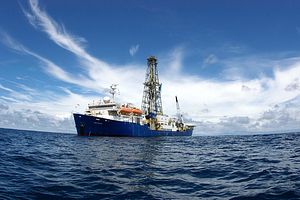The JOIDES Resolution set out on Tuesday for a 62-day expedition first proposed in 2008, undertaken largely because China was willing to pick up 70 percent of the tab. The results of the expedition will be shared around the world, thanks to an observer scientist from the Philippines on board. But, depending on what is discovered, this scientific expedition has the potential to escalate tensions in the South China Sea.
The vessel, from the U.S. National Science Foundation and under the auspices of the International Ocean Discovery Program, is set to drill in three different spots. Regarding the disputed areas, the Philippines has granted permission but approval from Vietnam is still pending.
For all of the grandstanding about sovereignty, the real battle over territory in the region is a matter of resources. The amount of oil in the South China Sea contributes to the heated diplomatic rhetoric over ownership of the territories, but no one is really sure how much oil and natural gas these areas hold. The U.S. Energy Information Administration, on the high end of the estimates, claims there could be 11 billion barrels of oil reserves and 190 trillion cubic feet of natural gas reserves. Even higher estimates from the Chinese National Offshore Oil Company claim that the area holds 125 billion barrels of oil and 500 trillion cubic feet of natural gas. However, low-end estimates, like those from energy consultancy Wood Mackenzie, guess that there are only 2.5 billion barrels.
Once the guessing game is over, the nations fighting with China over the territory will have real-world stakes, something that could escalate the already volatile state of affairs. This isn’t to say that cooperation isn’t possible; the past few years have seen a number of cooperative measures from various countries in the region. Brunei and Malaysia, for example, have a number of joint ventures of deepwater oil exploration that bode well for the region. The same can be said of Thailand and Vietnam in the Gulf of Thailand. However, with so many resources in the mix and a growing, expansionist China, an expedition yielding extremely positive results may do little more than cause China to dig in its heels.
Rhetoric from China on the South China Sea has been unwavering, claiming that such areas are an inalienable part of the PRC’s sovereignty. China’s words are bolstered by shows of strength, including the recent presence of the Chinese aircraft carrier Liaoning in the region. Actions such as the PLA moving in on James Shoal are serving to escalate matters. Earlier this week, PLA patrols of the shoal — just 80 kilometers from Malaysia’s Sarawak (1,800 kilometers from mainland China) — caused great concern, though those reports are now disputed. Xinhua wrote that the troops aboard the ships held “an oath-taking ceremony to safeguard the area’s sovereignty.” Similar patrols of the Nansha islands have also raised ire this month.
Meanwhile, this drilling expedition is one of the most ambitious ever undertaken in the region, with some sites possibly seeing drills 1,930 meters into the seabed. Once the JOIDES Resolution returns with its findings, the many countries with whom China has disagreements in the South China Sea may be willing to brave China’s bullying for a shot at the black gold.
































